Here the fastest and most extreme handheld console to ever exist Asus Rog Ally Gaming . and Nintendo Switch. Here we are going compare Rog ally vs Nintendo Switch to know which one is best. We cover Screen, Audio, Design, Controls, Performance, Gaming, and battery life so on. Lets Just Dive in the Comparison of Asus Rog Ally vs Nintendo Switch.
Note: This article contains Amazon affiliate links. If you make a purchase through these links, I may earn a commission at no extra cost to you.
Table of Contents
Unboxing
Rog Ally
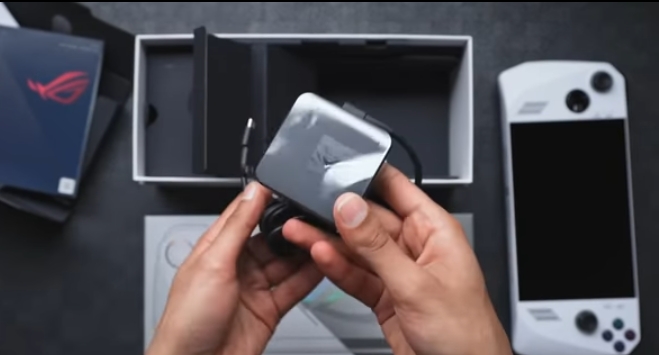
Starting with the unboxing experience, the ROG Ally (review) is packaged like a premium product, for sure. It’s a thick and meaty box, and the device itself basically takes up the entire space inside. Underneath, there’s not actually much; you basically get one side of the power adapter and the other side of the power adapter. And also a little cardboard stand hidden inside the lid.
Switch

Now, Nintendo Switch (review), on the other hand, tries a little less hard to come across as aggressively power-focused and instead just tries to make their packaging seem fun. It’s very bright and colorful. This is the fourth time I’ve unboxed one of these OLED Switch models, and honestly, it still feels exciting like Christmas morning. It also comes with a lot more inside the box. So, I slightly lean towards Nintendo for this point.
Audio
Switch
So, the Switch has two small speaker outlets at the bottom, and they are actually better than they look. We have the new OLED model, and one of the main changes over the original Switch is the speaker improvement.
Rog Ally
However, you can just tell by the positioning of the ROG speakers that audio is a central part of the experience here. Listen to this; it’s literally giving me goosebumps. The volume is much higher, probably 40 times louder. While the Switch sounds like a decent set of phone speakers, this has a level of crispness and punchiness that sits solidly two tiers above that.
Display
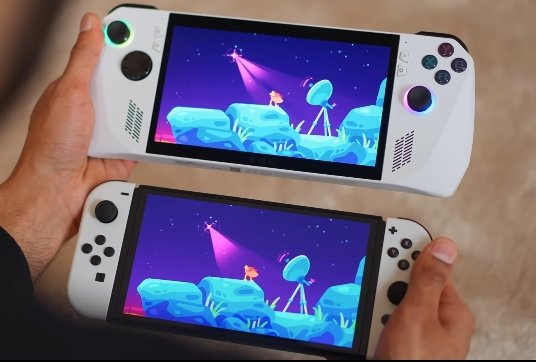
And then the screen. Now, considering that this Switch still has a 720p resolution, which I mean, it won’t be long until there are toothbrushes with more pixels, it is actually quite nice. Not the original Switch, the LCD panel on that is, oh, not good. But this OLED version has super deep contrast, color saturation pumped up to the maximum, and slimmer borders, which, to be honest, look a little more even than the thick top and bottom that we’ve got on the ROG.
This kind of aesthetic stuff matters to me, but you can’t ignore the difference in the quality of the panel itself. Rog ally is 1080p resolution, which means it’s more than two times the number of pixels. It runs at 120 hertz refresh rate, which is insane for a handheld game console and double the Switch. It peaks at around 500 nits of brightness, which is not close to top-end phones but better than the 400 nits of this Switch.
The Switch OLED ships out of the box with a vivid color mode on. I think Nintendo has done that to make sure it feels differentiated from the original Switch’s more muted colors. But if you actually want to play games in the way that developers intended or browse the internet in a way that doesn’t make it feel like you’re using a children’s toy, then you’ll actually want accurate colors, which the Switch OLED can sort of do. But even when you turn Vivid mode off, it’s not as accurate as this.
So far, that’s two points to one point. Initial impressions are really strong.
Accessories
Then, I try to integrate both of these into my day-to-day life, and I started to notice some frictions, like accessories. One of the things that I love to do when I get a new gadget is to find an ecosystem of accessories that allows me to make the most of it. And, to be fair, there are a few interesting accessories that you can buy for the ROG
Rog Ally

- Ketra Wireless Earphones: The Ketra wireless earphones are both super low latency and have active noise cancellation. Musically speaking, these are not the best-sounding earphones, but they’re quite purpose-built for gaming.
- The Raikiri Pro: Which is basically a souped-up Xbox controller, is definitely cool. There’s customizable RGB lighting on the front, buttons all the way around, not just on the front. It even has an OLED display that lets you load up your own animations.
- Rog gaming Charger Dock: ROG has even made a gaming charger dock which effectively mimics the functionality of the Nintendo Switch dock as closely as possible without getting sued for copyright. It can charge the Ally like the dock, while charging an accessory like the dock, and also provides HDMI connectivity to connect to a TV for playing, just like the dock.
Switch

Just by the very nature of the Switch being a single piece of hardware that over a hundred million people have bought, it naturally means that you’re going to be able to find a lot more things that are specifically made for it. You can find various types of cases, controllers, car holders, Switch cartridge cases, and all sorts of ridiculous ways to customize its look. And because there is competition in the market for Switch accessories, you can also find many of them at a cheap price.
On the other hand, for a more niche product like the ROG Ally, you might find a couple of skins and a carrying case online. I did find that the joystick covers made for the Nintendo Switch can actually work with this device. However, there’s a difference between using something that can work and using something that’s made specifically for you.
Portability and Comfort
Technically, both of these are portable; both will fit in a rucksack or a suitcase. But I did not anticipate just how much of a chungus this ROG was going to be. The Switch takes up genuinely half the volume, and the fact that the controllers do just slip off like this means that, if you really, really want to, you actually could fit all of this into your pockets.
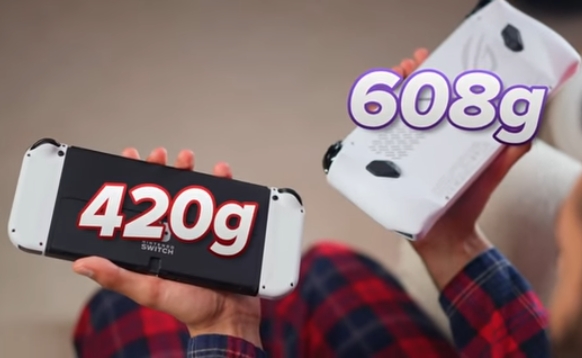
But the Ally’s thickness also affects what it’s like to use the Ally. The comfort, because on one hand, the fact that the Switch is so slim and the controls are detachable gives it a slightly flimsy, rattly feeling that is not the case with the Ally. I can’t tell you how good it feels to finally have a nice, substantial, textured unit to wrap your hands around.
The downside, though, is that it also means it’s heavier: 608 grams versus 420. Oh, nice. When I first started using it, I didn’t think that would matter considering the vast difference in volume. I was actually expecting it to be heavier than it is. But long-term, you start to notice something. While the Switch is just light enough to comfortably hold while you’re standing or lying in bed with it hanging over your face, with this, you’re constantly finding yourself searching for a surface to lean on and take some of that weight off.
Now, to be fair, I think the company knew this. That’s why they basically chopped off the edges here and sloped the handles in, so they don’t dig into your palms. But the point is, it feels bulky, especially after an hour of playtime. Plus, I don’t really like this rear button placement. They’re not comfortable to press, and you kind of have to dig into the back of the console. Besides, when my fingers are resting, I don’t want buttons sitting right underneath them.
All of this stuff adds up together to mean that when you go from this to actually just holding this in your hands, you really appreciate just how clean the Switch feels. So, for me, Nintendo is a bit of a no-brainer for comfort.
Controls
However, there’s a flip side. The benefit of not having to squeeze every single button into this tiny chassis is that these controls are leagues ahead.
Switch

One common complaint about the Switch buttons is their size. While they’re responsive, they feel sharp, clicky, and tight. The analog sticks are another weak point; they’re shorter than those on traditional console controllers, perhaps for portability. However, this sacrifices some control, as they feel more like small nubs. Then there’s the issue of joy-con drift, which has plagued Switch users since day one. Essentially, the contact point behind the joysticks isn’t of high quality, causing them to register inputs even when you’re not touching them. While it can provide a convenient excuse for losing in Mario Kart, it’s serious enough that anyone who games on the Switch often should consider investing in an external controller.
Rog Ally
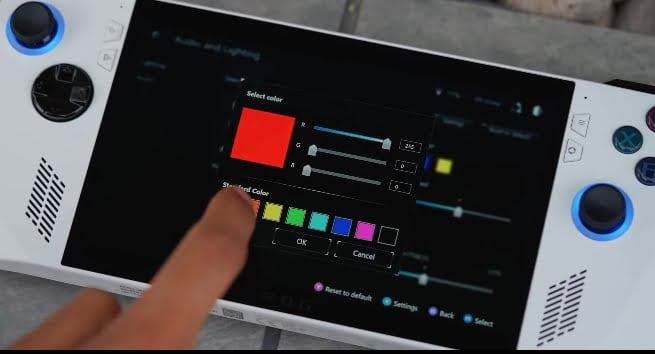
Again, not the Ally. There’s a big difference between shoulder buttons that have tight, any-better travel and almost feel like on-off buttons, versus smooth console-quality ones like these. All the buttons are just as responsive but softer at the same time. The joysticks glide with a wide range of movements and obviously also have RGB rings around them. They’re a nice little customization touch, and you can mess with the settings. But on a device where you actually do need every minute of battery that you can get, I will be turning them off the second this article finishes.
Now, that’s not me saying that I think these controls are going to be completely free from issues. I have, on a few occasions, had the odd key press not register properly. I’ve had it registering key presses that I’m definitely not making in some games. The joysticks, while smooth, do feel a little floaty and not the most precise. And on three separate occasions, my X button has stayed down when I pressed it. It’s a little worrying because, unlike with the Switch where if the controller goes wrong, you can just swap it out for another one, you’re kind of stuck with what you get with the Ally. But they don’t feel like structural issues that are going to cause long-term problems. It still makes me lean slightly towards the ROG as the lesser of two evils when it comes to control.
Operating System
So just before we get to the games and the graphics, we need to talk about the single biggest difference between these two: the software.
Switch
The fact that the Switch is running Nintendo’s own operating system and that the ROG Ally is a Windows device. And what this translates to is the Switch being this super polished experience, but one that’s very controlled, and the ROG being pretty unrefined, but something that you can do whatever you want with.
Both can be great, like honestly, I love the fact that when I’m playing games on my Switch, it’s such a thoughtless experience. You grab a cartridge, you slip it in, you open it, and often within 10 seconds, your game is loaded. You don’t need to think about anything else apart from just what game do I want to play.
But then with the ROG, and basically any Windows gaming handheld, you’re constantly being reminded that this is not what Windows was made for. You’ll get these tiny, fiddly menus that you can barely read, and I’ve been having to prod around with my oversized fingers to interact with them. And this is using the Steam interface, which is as optimized as it gets for gamepads like this.
There’s a sense of reassurance you get knowing that whenever a game releases on the Switch, it will have been designed to factor in the exact button layout that everyone has. So the developers would literally be testing their game on a Switch, thinking, “Okay, this action would probably be more comfortable for this button,” and so on.
Rog Ally
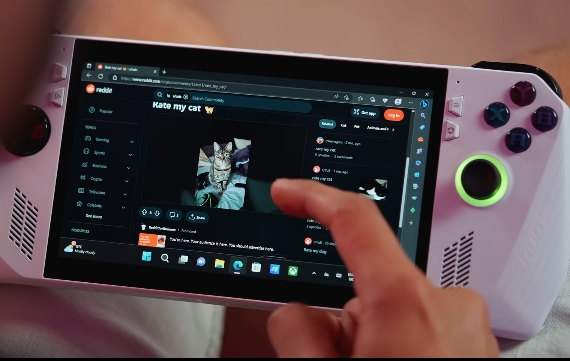
But it’s the other way around here. The Ally is designed to approximate an Xbox controller, which is what some PC game developers cater to alongside the main focus on mouse and keyboard. So, when you launch a game and select Gamepad modes, you are very much an afterthought.
In some cases, the controller is automatically set up for you, but sometimes the buttons are mapped in a really odd way. Other times, games are convinced that you have a keyboard attached. I’ve lost count of the number of times something has told me to press the spacebar to continue.
PC versions of games, in general, tend to receive less effort in terms of optimization and quality control compared to consoles. This is because there’s no one company at the top taking responsibility for it. On top of all that, Windows is not designed to suspend video games without consuming power. So ideally, when you plan on putting the device down for even a day, you should manually close each game first to preserve battery. The Switch, being purpose-built for this exact job, efficiently handles it without any worry.
Windows, on the other hand, has its own issues but can also be a blessing because it means that this device can do anything your main computer can do. You get a proper desktop-class browsing experience. It can be used to store and display photos as a slideshow. The power button even doubles as a fingerprint scanner, providing additional security.
Furthermore, with the use of a USB hub, it can become a full computer with keyboard and mouse support. The HDMI output allows for connection to a monitor, and since the Rog is no longer concerned about battery life when plugged in, it can divert more power to its chip, resulting in faster performance.
So, while the Switch offers more hardware flexibility with its limitless customizable accessories, the Rog Ally excels in software flexibility.
Games Library
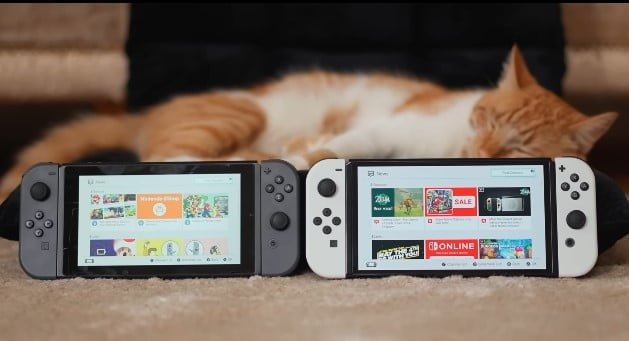
Now, I’m personally not going to do much of that. I use a laptop when I want to actually get stuff done, and I just want this to game. So for me, having Windows is more of a burden than an opportunity. But then on the other hand, if you were going to use this as your everything device, it can do a whole lot more. And of course, your operating system also affects which games you can play.
When I first started using this, I thought, “This is a no-brainer. This thing can play proper full PC-quality titles.” The same real open-world, limitless, massive multiplayer games that are made for next-generation consoles, on the go, and a basically bottomless library of them since PC games have been being made since 1983. This is the dream, right? Plus, it can even emulate older console games. I mean, yeah, you can also emulate some games on the Switch, but it’s not an ideal situation. Nintendo severely restricts what you can play and charges you stupid amounts to do it. But with the Ally, you can basically just download a piece of software called EmuDeck and play any console game right from the very beginning, all the way up to, ironically, the Nintendo Switch.
Now, I don’t personally play many retro games. I’m more of the opinion that games are continuously improving, and that anytime it seems like all the games were better, that’s nostalgia talking, and that within five minutes of playing those older games, you’ll be reminded that they’re not. But lots of people do like it, so it is a great perk to have. However, there are three important caveats to the game library on Windows.
First, you’re probably never going to get Nintendo’s first-party games. No Mario, no Smash, no Pokémon. Which, for me, if I could only pick one of these new consoles, I would feel their absence. You could go down the emulation route, but that never normally works as smoothly as running a game made for a platform.
Second, the games you do get instead are made with home PCs in mind. They’re the kinds of games that are designed to either be played online or, failing that, update often or check in online every time you open them. So let’s say you’re about to do a long stretch of traveling and you wanted the ROG Ally to be your gaming device. You would actually have to prepare to make sure that the games you want to play are actually available offline.
And then the third part of this, which for me is the most devastating, is that most of these PC games are not designed with split-screen or co-op in mind. PC gaming isn’t really about sitting on the couch with friends and busting out some multiplayer. It tends to be, “You’re in your gaming cave, I’m in my gaming cave, let’s play online together.” But for me, the best part of gaming is this multiplayer. I want to be able to see the smile slowly disappear off my opponent’s face as I beat them at something. And in that sense, it’s just not close to the Switch. And so many of its games are designed to be multiplayer. You literally just slip off one of these for yourself, you hand the other to your friend, and you’re playing together.
So while it is absolutely wild that this allows you to basically play Halo Infinite in the palms of your hands, most of the gaming experience around the games themselves feels clunky for a handheld and quite a solo endeavor. So overall, I would call the game libraries a draw.
Price

The Nintendo Switch OLED is priced at $300, while the Rog Ally starts at $600, with the extreme model at $700. Are people really deciding between these two? Yes, there’s a price gap. The Rog Ally is pricier because it’s high-end equipment, and Rog makes a profit from this hardware. Once you buy the Rog Ally, Rog doesn’t own you; you’re just using another Windows device. You buy your games off Steam without any subscription cost to Rog. But with Nintendo, you’re getting a closed system with its own custom Nintendo operating system, putting you at Nintendo’s service. They often sell consoles at a loss to make profits later through their software.
The upfront cost of each device doesn’t tell the whole story. For instance, Mario Kart on a Nintendo Switch costs $50, and so does Zelda: Breath of the Wild, even though these games are six years old. This is because Nintendo controls the platform and pricing without competition between storefronts. In contrast, top-tier PC games from the same year, like Resident Evil 7, may cost $7, Sniper Elite 4 is $5, and Call of Duty: World War II is $19.
New PC games are initially priced similarly to Nintendo’s, but they quickly drop in price with more discounts. Buying the biggest games on each platform can save you hundreds, not including subscriptions like Game Pass for Windows devices.
The $700 Rog Ally also offers 512 GB of storage compared to the Switch’s 32 GB, but you may need to pay to expand it. Additionally, you don’t need to pay to play online with the Rog Ally, while with Nintendo, multiplayer gaming requires a $4 monthly subscription. In the long run, the costs of both devices may even out.
Performance
You might expect this device to be significantly more powerful than the Switch, and you’d be right. The Nintendo Switch runs on a mobile chip by Nvidia, which was quite powerful for its time in 2015. It’s paired with four gigabytes of RAM. Now, the Rog Ally boasts 16 gigabytes of super-fast RAM, along with an AMD Ryzen Z1 Extreme chip. This is top-tier mobile gaming hardware, unmatched by anything else. It’s rated as over two times more powerful than even the Steam Deck and a whopping 21.5 times more powerful than the Switch.
This superiority extends to internet speed as well. The Rog Ally connects more reliably and achieves better speeds when connected. This difference is accentuated by the fact that Nintendo doesn’t invest enough in their online servers. So, when gaming online, despite it being a paid service, you can often feel the lag on the Switch.
Graphics

As for what all of this power actually means for the graphics of the games themselves, well, we can actually pull up the same game on both devices to test it. Let’s take The Witcher 3, for example. Originally made as a vast open-world game for high-end machines, people were shocked that they even made it run on the Switch. But here we are.
You notice the resolution difference right away. The Rog is perfectly happy at 1080p, but the Switch can’t even play the game at the 720p resolution of its screen. Instead, it settles for 540p, which is about a quarter of the resolution. Then, there’s the frame rate. The Rog is definitely not struggling here. It’s running the game at around 40 to 50 frames per second, which is smoother than the Switch’s 30 frames per second, but not buttery smooth.
But it’s the game effect where the Rog really separates itself. It’s running the game at high settings, with a few nice-to-have extras like ray tracing turned off. And what makes that kind of crazy is that we’re talking about high settings for a proper PC, for a full-size tower and monitor, sit-down-at-your-desk-and-play kind of experience. Holding that level of performance in your hands feels almost unreal. It feels like it shouldn’t be possible. When it works and when you get a game where the control scheme adapts well and the PC port is well optimized, you feel like you are holding the future. That’s the feeling that this entire concept exists for.
But it’s just that there is so much baggage you have to deal with to get there, and nowhere is that more apparent than in battery life.
Battery Performance
So both devices are set up and fully charged. It’s around 9:30 in the morning, and one thing you’ll immediately notice is the difference in how much time you spend waiting for things to happen on the Rog. I booted up this exact same game yesterday, but it’s still taking a significant amount of time to actually get into it. The battery is much bigger on the Rog than on the Switch, but there’s a vast difference in power consumption between a mobile-based chip and a PC-based chip that didn’t originally prioritize power efficiency.
Not even factoring in the fans, normal PCs naturally have great airflow. However, because the Rog Ally is a compact device, it has to create its own airflow using some very loud and energy-inefficient fans. Oh, it seems I managed to get myself stuck in the game, which is actually perfect for testing purposes. Let’s leave Mario racing and my other car stuck on a rock and see how long it takes for their batteries to run out.
After just one hour and 28 minutes of gameplay, the Rog’s battery is already depleted. In contrast, the Switch is still going strong at this point, with 69% battery remaining. It’s almost like you planned that, Nintendo. Personally, for me, this is a deciding factor. Sure, you could argue that the Rog is running a proper PC title while the Switch is running Mario Kart. But that’s the entire point of the device. The Rog is meant to provide a high-quality gaming experience. However, you can force the chip to consume less power and extend the battery life to around four hours, but that would require scaling down the game’s quality to a level comparable to the Switch’s graphics.
My Final Thought
The feeling that the Rog can give you when everything works perfectly is essentially everything I’ve ever dreamed of since I was a child. However, unless you’ve thoroughly researched and are willing to tolerate all the grievances that come with it, for an average user, I believe the traditional handheld, like the Switch, is still the better option. Additionally, it’s worth mentioning that the Switch is due for an upgrade in the next couple of years, which should hopefully bridge the gap in terms of graphics while also providing the conveniences of a purpose-built gaming machine.






